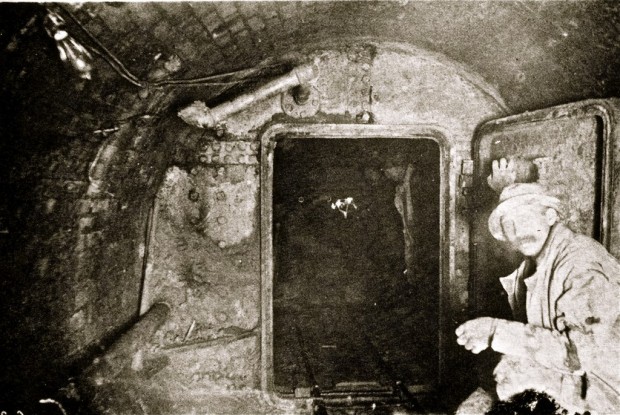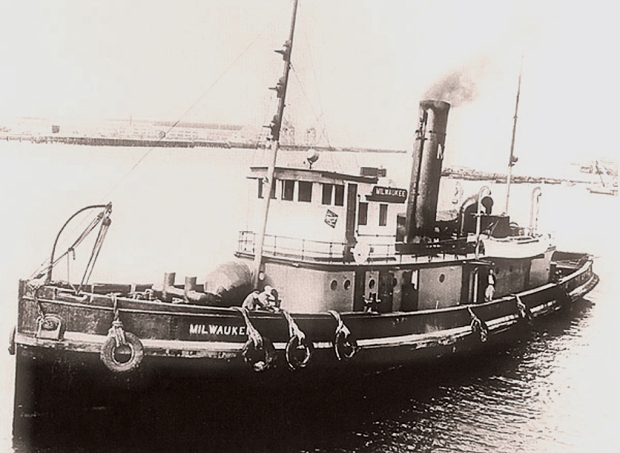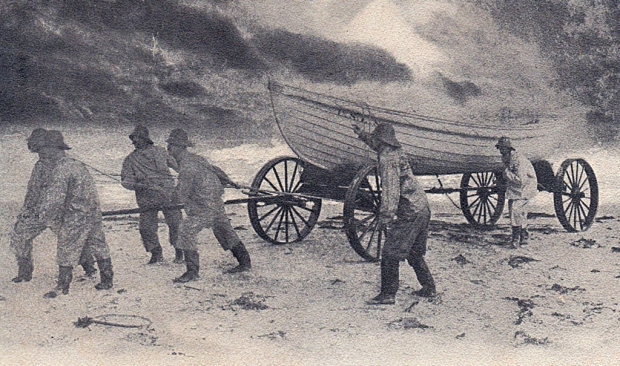
In 1893, Surfman Ingar Olsen of the U.S. Life-Saving Service in Milwaukee performed one of the most daring rescues in Lake Michigan history.
Ingar Olsen, a 22-year-old surfman with the Milwaukee station of the U.S. Life-Saving Service, was never able to explain his actions on April 20, 1893. With near-hurricane winds whipping a bitterly cold Lake Michigan into towering, violently churning waves, Olsen’s crew struggled through the storm in an open rowboat to reach a lone man, unconscious, near death, and clinging to wreckage 3,000 feet off Bradford Beach.
Olsen said, “As we finally maneuvered into position, I unconsciously dropped my oar, picked my way between the other men in the boat … and made a dive. No command had been given and weeks later, when I was asked to explain how I happened to do what I did at the time, I was unable to give any explanation … it was just as though an unseen hand was guiding my actions.”
Against incredible odds, Olsen was about to make one of the most dramatic rescues in Lake Michigan history.

Digging the water intake tunnel deep under Lake Michigan in 1891. Courtesy Milwaukee County Historical Society.
Twenty years before, in 1873, Milwaukee took a major step to improve public health. The city’s new waterworks pumped relatively clean water from Lake Michigan to a reservoir at North Avenue. From there, the water was then sent to consumers just as it was – untreated and unfiltered. (It was not uncommon to turn on a tap and have a tiny fish fall into the sink.) Still, it was still much healthier than the prior practices of using shallow residential wells, often dug next to cess pits, or drawing water from the heavily polluted Milwaukee River.
In the early 1890s, the city started work on an extension to the Lake Michigan intake. Workers began by building a small island – called a “crib” – 3,000 feet off Bradford Beach. Built of timber pilings and large rocks, the crib was octagonal in shape and 100 yards in diameter. From this manmade island, workers dug a shaft 140 feet down and then started to drive a tunnel to shore that would eventually house two 60-inch intake pipes.
While the work progressed, the engineers, miners, and bricklayers lived in a large timber structure on top of the crib, which also housed the tools, compressors, and other necessary machinery. Wary of Lake Michigan storms, the contractor made the shelter walls of 12-inch-thick timbers.
It was a substantial building, but it was no match for the intense storm that struck Milwaukee on the night of April 20, 1893.
“There was a strong northeasterner blowing and as the night wore on it increased in violence until it was registering 65 mph and churning up the lake with a fury that spelled disaster for anything in its path. To add to the dangers of the night it began to sleet and the wind whipped the sleet before it until it cut through one like a knife.” – Ingar Olsen, as told to the Milwaukee Sentinel, May 8, 1931, edition
At dawn, onlookers gathered at the lakefront could see the crib shelter had been swept away by the storm. A splintered platform around the iron shaft was all that remained.

The tunnel under Lake Michigan was fitted with airlocks, which served to keep the men alive for a few hours until, inevitably, the air began to give out. This photo was taken about 1891. Courtesy Milwaukee County Historical Society
While there was concern over the fate of the 15 workers on the crib, there was also the reassuring knowledge they likely had taken shelter behind the watertight doors of the tunnel. In fact, the workers evacuated the timber house at 10 p.m. the previous night. Huddled in the tunnel, they spent a dry and relatively comfortable night. When morning came, they realized the air supply compressor, located in the crib building, had failed, water had filled the access shaft, and the air in the tunnel was rapidly giving out.
Then one of the workers died. Moments later a second died. Someone struck a match and looked at his watch. It was 7 in the morning. Rather than suffocate in the tunnel, they decided to open the airlock door to the flooded shaft and attempt to fight their way to the surface. Water roared in as the men struggled to escape the tunnel. Six made it to the surface. Onlookers from shore – some of them the workers’ own wives and children – could see the men clinging to the wrecked platform, constantly battered by massive waves.
As they watched, one by one the workers were swept to their deaths in the churning waves. One question was on everyone’s mind – where was the life-saving service?
Ingar Olsen and the other men of the Milwaukee Station of the U.S. Life-Saving Service had been out all night rescuing the crew of a schooner blown aground. Exhausted, soaked to the skin, and half frozen, the surf men had just returned to their station when a man on horseback galloped up shouting that the crib had been swept away. They immediately set out for Bradford Beach, rolling their surf boat through the city streets on a wagon. However, an axle broke on the wagon as they reached South Water Street.
The leader of the life-saving service rushed to the nearby tugboat office, where Capt. Bill Gnewuch of the tugboat Welcome agreed, at great risk to himself and his crew, to tow the surf boat through the storm to the wrecked crib.

The captain of the tugboat Welcome risked his life and the lives of his crew to assist in a rescue in the midst of a violent Lake Michigan storm.
Ordinarily, it was a 10-minute run with a tug to the crib, but this was no ordinary day. It was almost four hours later before we came within hailing distance of the crib. There were seven of us in the lifeboat as we cut loose from the tow line and we were being tossed about like a cork, one minute riding the crest of a wave 10 feet high and the next being hidden from sight of those on the tug as we dipped. Through the murk and the spray we finally caught sight of the crib, or rather what remained of it. Horrified, we discovered that the house had been completely washed away and that only a few broken timbers remained of the crib. – Ingar Olsen, as told to the Milwaukee Sentinel, May 8, 1931 edition
As the surf men struggled to get to the platform, they could see two survivors. A moment later, one of them was swept away to his death. Olsen waited no longer. He dived into the surging waves and swam through the ice-cold water to a piling. From there, Olsen cautiously picked his way through the waves and wreckage to reach the remaining survivor, who he later learned was James Miller, the foreman of the tunnel workers.
A giant of a man, over six feet tall and weighing 235 pounds, Miller was unconscious – but a cable wound around an arm had prevented him from being swept away.
First, I took off my life-preserver and tried to put it on Miller. Trying to maneuver the inert form into proper position as the icy sea beat against us and sought to wash us from our perilous perch was a job that taxed my remaining strength. Finally, with this accomplished, the crew of our lifeboat threw me a heaving line, which I tied securely around Miller’s body. Watching my chance for a lull in the waves, I picked Miller up bodily, managed somehow to get him on my back and crawled with him to the lee side of what remained of the crib, and dumped him over for the crew to haul in.– Ingar Olsen, as told to the Milwaukee Sentinel, May 8, 1931 edition
The crew then threw a rope to Olsen. He had been on the crib for two hours and barely had strength to make it back to the surf boat. Olsen later said he could remember nothing of the trip back to shore.
Olsen earned a gold medal for his actions on the morning of April 20, 1893. He would stay with the Life-Saving Service, later part of the U.S. Coast Guard, and would retire as the Milwaukee station commander. Miller, the man Olsen rescued, made a full recovery, and a new job took him out-of-town. The two met years later to reminisce about the horror, and heroism, of that day.


I was truly riveted by this amazing and exciting story! What a courageous act.
LikeLiked by 1 person
Wow, what a great and moving story. I appreciate the effort finding the accompanying photos. Thanks for sharing these heroic deeds, Carl!
LikeLiked by 1 person
Just to let you know, the name of the tug Welcome’s Captain (my ancestor, which is how I know) was William Gnewuch, not Bill Yunevich. He was also the son of a Gold Medal awarded (1881) captain, Charles Gnewuch of Manistee, MI, so helping out with this kind of thing ran in his family.
LikeLike
Wow! Like father, like son! Thanks for pointing out the spelling error — I’ve changed it in the text.
LikeLike
I’m trying to find the names of the men who died. One of my ancestors died in Lake Michigan on this exact date, but he was Captain Burton, and not connected with the water works, as far as I know.
LikeLike
I have a picture of Ingar Olsen when he was station on Plum Island from my great great grandfather who was also a lighthouse keeper
LikeLike